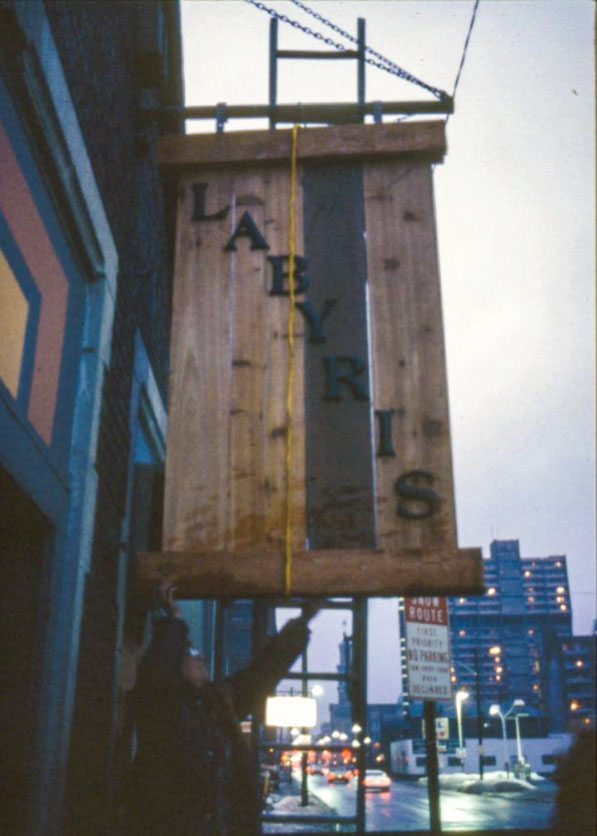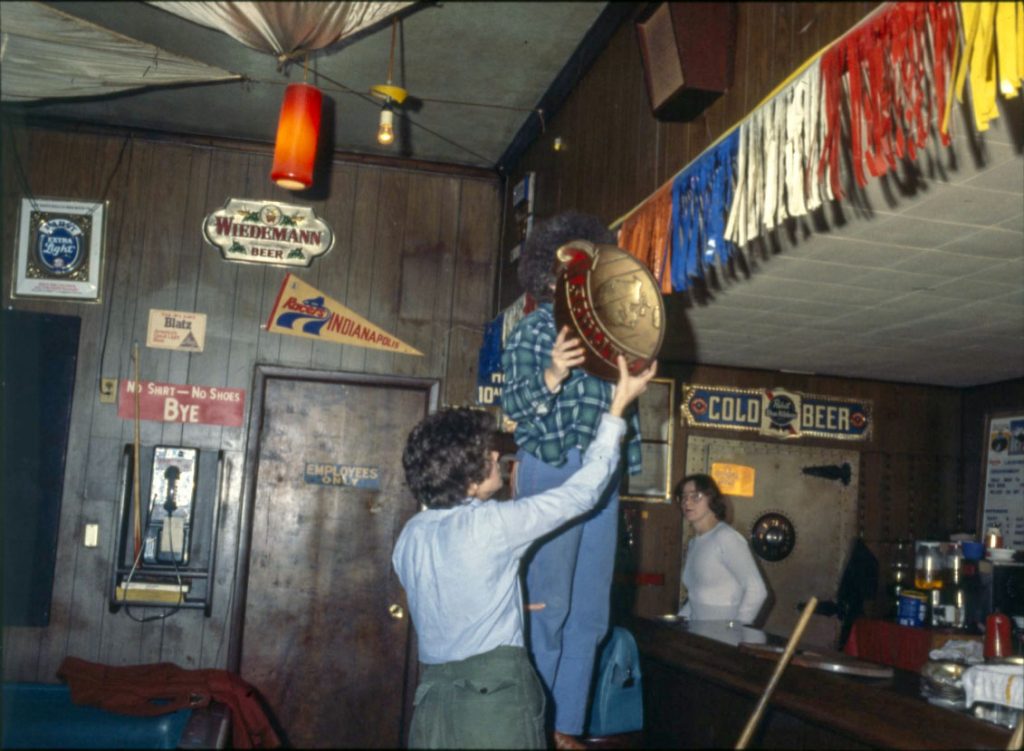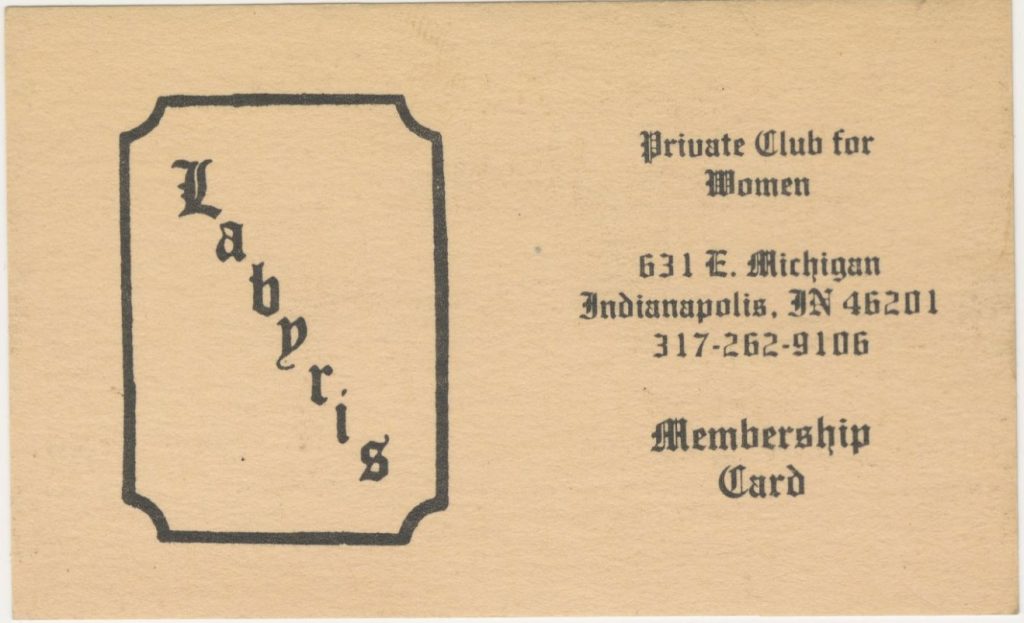Former social-service administrator Mary Byrne operated the feminist bar Labyris from March 1979 until 1984 in the district. The bar provided a safe space for both straight and lesbian women to form a community and relationships, whether platonic or romantic.

The name of the bar derives from the labrys, a double-bladed axe featured in Ancient Greek mythology, which became a common symbol adopted by 1970s lesbian communities to symbolize strength and self-sufficiency.
Labyris maintained an active event calendar that showcased creative and political events. Bar patrons shared music and poetry at open mic nights, mingled during arts and craft markets, played euchre, competed in pool tournaments, and witnessed rowdy theatre revues. Labyris promoted women’s and LGBTQ+ issues through letter-writing campaigns to Congress and movements to promote local women’s sports, which witnessed expanded participation opportunities after the 1972 passage of federal Title IX legislation (see ). The bar hosted fundraisers for Indiana’s (NOW) chapter, a feminist organization dedicated to women’s rights in Indiana.
Though Labyris flourished as a safe space for women, Byrne also envisioned women’s music as a way to advertise and draw large crowds to the bar. Women’s music emerged in the 1970s as a distinct style distinguished by the activism of second-wave feminists and lesbian separatists. Those involved in this new diverse genre of music emphasized community and supported women through the arc of their music production. Both nationally known feminist singers and local talent occupied Labyris’s stage, often drawing large crowds to the venue. At its peak, the bar hosted fifty concerts a year, including notable touring acts such as folk singer-songwriters Holly Near, Toshi Reagon, and Cris Williamson; guitarist June Millington; and synth-rock band leader Lē Weaver.

For all Labyris’s success as a safe space for women, the bar faced an immediate and fierce backlash from the broader Indianapolis community. On opening night in March 1979, Byrne claimed that someone slashed the tires of more than 20 vehicles parked at the venue. To prioritize women’s safety and weed out troublemakers, Byrne resorted to locking the entrance to the venue to monitor and vet bar patrons.
Byrne added other safety measures during the first few years of operation. A females-only membership program enabled Byrne to admit or deny patrons at the door. Members received special guest passes to bring non-members and male guests. To deter agitators, Byrne charged a steep door fee of $10—an exorbitant amount during the late 1970s and early 1980s. The membership program and door fee faded from use when Indiana Alcohol & Tobacco Commission officials warned Byrne of the illegality of these practices.


Credit: Indiana Historical Society (left and right)
Backlash against Labyris’s practices also came from within the LGBTQ+ community. The extreme security measures and focus on women clientele left many men in the larger community feeling resentful. In 1982, widely believed rumors circulated that Labyris charged a higher door fee for gay men to enter. magazine published Byrne’s response to the allegation, stating that she reimbursed the $10 door fee to all official members of the nightclub and that Labyris did admit men, though Byrne preferred an all-women clientele. Some members of Labyris criticized the women’s revues, which featured all-female cast members in shows that loosely resembled . Drag shows remained highly controversial forms of art that Indianapolis LGBTQ+ bars such as Our Place, the Varsity Lounge, and Jimmy’s did not permit. Criticisms were commonplace within radical feminist and lesbian activist circles of the 1970s, with some opponents claiming that drag was an avenue for men to mock and caricature women and traditional presentations of femininity.
In 1984 business steadily declined, prompting Byrne to shut the bar to focus on her work for the National Women’s Music Festival in Bloomington, Indiana. However, over the bar’s years of existence, membership had grown from fewer than 200 to more than 1,200. In Labyris’s absence, few bars oriented toward lesbian, feminist, or primarily women clienteles remained in Indianapolis.
FURTHER READING
- WFYI Public Media. “Labyris,” June 21, 2023. https://www.wfyi.org/programs/cultural-manifesto/radio/labyris.
CITE THIS ENTRY
APA:
Schabel, G. (2025). Labyris. Encyclopedia of Indianapolis. Retrieved Dec 12, 2025, from https://indyencyclopedia.org/labyris/.
MLA:
Schabel, Gipson. “Labyris.” Encyclopedia of Indianapolis, 2025, https://indyencyclopedia.org/labyris/. Accessed 12 Dec 2025.
Chicago:
Schabel, Gipson. “Labyris.” Encyclopedia of Indianapolis, 2025. Accessed Dec 12, 2025. https://indyencyclopedia.org/labyris/.

Help improve this entry
Contribute information, offer corrections, suggest images.
You can also recommend new entries related to this topic.